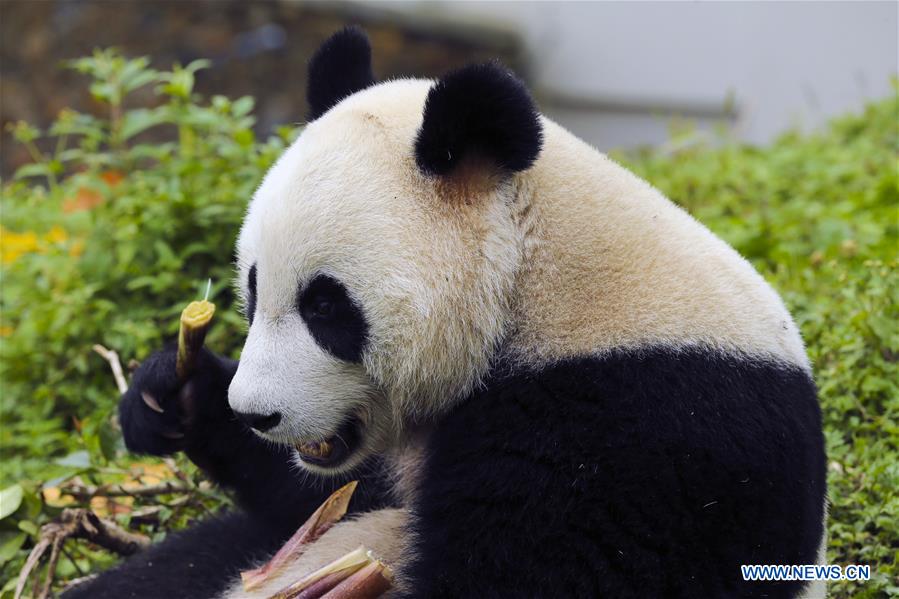


A giant panda eats bamboos at Shenshuping protection base in Wolong National Nature Reserve, Southwest China's Sichuan province, Oct 20, 2017. [Photo/Xinhua]
The China Conservation and Research Center for the Giant Panda in Wolong National Nature Reserve in Sichuan province said on Wednesday it had started rebuilding a fence where a visitor had touched a panda cub.
It was making the fence higher so that visitors cannot reach the pandas and it asked visitors to keep away from the animals. It asked them to refrain from climbing over the fence and from feeding or touching the pandas, said Wang Jisi, an information officer at the center.
On April 7, a woman surnamed Han said in social media that she and somebody else had managed to touch a panda cub without the consent of the center.
From the nine photos uploaded by Han, people could see three panda cubs frolicking behind a green fence and climbing the fence, along with two human hands touching the nose and head of a cub. The one touching the head had red nail polish.
The post angered netizens who criticized Han for endangering the cub, fearing diseases from humans might pass to the animals.
A week later, Han deleted her posts, saying she loved pandas and would behave herself in the future. She also said she loved other animals and kept two dogs at home.
One netizen condemned Han for not considering the spread of the canine distemper virus to the panda cub from her two dogs.
The virus was reported to have caused the deaths of captive giant pandas in 1997, when three of the bears died at the Chongqing Zoo in Sichuan's neighboring Chongqing municipality.
Another outbreak in Shaanxi province caused the deaths of five pandas between December 2014 and April 2015.
Pandas are docile but can be fierce. In 2005, a female photographer from Hong Kong jumped into a panda enclosure to take photos. To the surprise of onlookers, the panda slashed one of her arms, causing profuse bleeding, the center said.
Zhou Mengqi, a veteran photographer in Chengdu, was chased by a panda that had been eating quietly until he took pictures of the animal up close at the Chengdu Research Base of Giant Panda Breeding in the early 1990s.
"Its claw touched my shoes before I escaped through a door," he said.
China has a total of 548 captive pandas. Of those, 285 are in the China Conservation and Research Center for the Giant Panda and 196 live at the Chengdu Research Base of Giant Panda Breeding.
 Fire brigade in Shanghai holds group wedding
Fire brigade in Shanghai holds group wedding Tourists enjoy ice sculptures in Datan Town, north China
Tourists enjoy ice sculptures in Datan Town, north China Sunset scenery of Dayan Pagoda in Xi'an
Sunset scenery of Dayan Pagoda in Xi'an Tourists have fun at scenic spot in Nanlong Town, NW China
Tourists have fun at scenic spot in Nanlong Town, NW China Harbin attracts tourists by making best use of ice in winter
Harbin attracts tourists by making best use of ice in winter In pics: FIS Alpine Ski Women's World Cup Slalom
In pics: FIS Alpine Ski Women's World Cup Slalom Black-necked cranes rest at reservoir in Lhunzhub County, Lhasa
Black-necked cranes rest at reservoir in Lhunzhub County, Lhasa China's FAST telescope will be available to foreign scientists in April
China's FAST telescope will be available to foreign scientists in April "She power" plays indispensable role in poverty alleviation
"She power" plays indispensable role in poverty alleviation Top 10 world news events of People's Daily in 2020
Top 10 world news events of People's Daily in 2020 Top 10 China news events of People's Daily in 2020
Top 10 China news events of People's Daily in 2020 Top 10 media buzzwords of 2020
Top 10 media buzzwords of 2020 Year-ender:10 major tourism stories of 2020
Year-ender:10 major tourism stories of 2020 No interference in Venezuelan issues
No interference in Venezuelan issues
 Biz prepares for trade spat
Biz prepares for trade spat
 Broadcasting Continent
Broadcasting Continent Australia wins Chinese CEOs as US loses
Australia wins Chinese CEOs as US loses